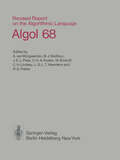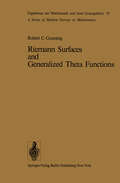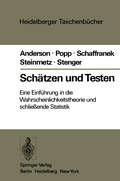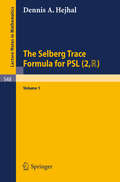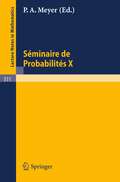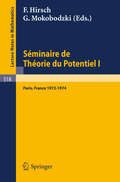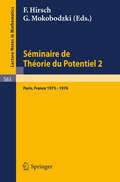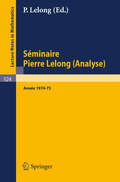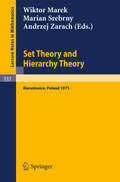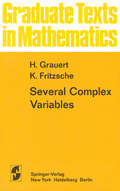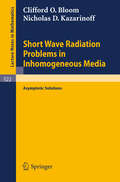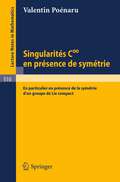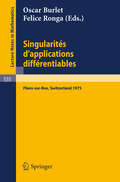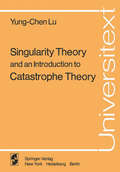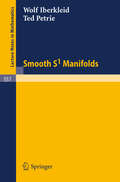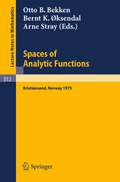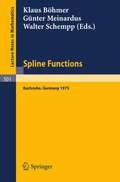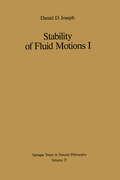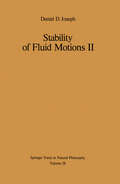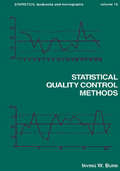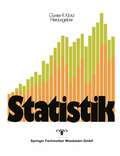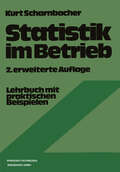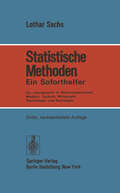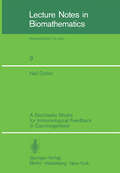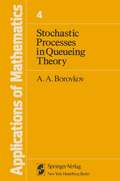- Table View
- List View
Revised Report on the Algorithmic Language Algol 68
by A. Wijngaarden B. J. Mailloux J. Peck C. Koster C. H. Lindsey M. Sintzoff L. T. Meertens R. G. FiskerRiemann Surfaces and Generalized Theta Functions (Ergebnisse der Mathematik und ihrer Grenzgebiete. 2. Folge #91)
by Robert C. GunningThe investigation of the relationships between compact Riemann surfaces (al gebraic curves) and their associated complex tori (Jacobi varieties) has long been basic to the study both of Riemann surfaces and of complex tori. A Riemann surface is naturally imbedded as an analytic submanifold in its associated torus; and various spaces of linear equivalence elasses of divisors on the surface (or equivalently spaces of analytic equivalence elasses of complex line bundies over the surface), elassified according to the dimensions of the associated linear series (or the dimensions of the spaces of analytic cross-sections), are naturally realized as analytic subvarieties of the associated torus. One of the most fruitful of the elassical approaches to this investigation has been by way of theta functions. The space of linear equivalence elasses of positive divisors of order g -1 on a compact connected Riemann surface M of genus g is realized by an irreducible (g -1)-dimensional analytic subvariety, an irreducible hypersurface, of the associated g-dimensional complex torus J(M); this hyper 1 surface W- r;;;, J(M) is the image of the natural mapping Mg- -+J(M), and is g 1 1 birationally equivalent to the (g -1)-fold symmetric product Mg- jSg-l of the Riemann surface M.
Schätzen und Testen: Eine Einführung in die Wahrscheinlichkeitsrechnung und schließende Statistik (Heidelberger Taschenbücher #177)
by O. Anderson W. Popp M. Schaffranek D. Steinmetz H. StengerSéminaire de Probabilités X: Université de Strasbourg (Lecture Notes in Mathematics #511)
by P. A. MeyerSéminaire de Théorie du Potentiel, Paris, 1972-1974, No. 1 (Lecture Notes in Mathematics #518)
by M. Brelot F. Hirsch G. Choquet G. Mokobodzki J. DenySéminaire de Théorie du Potentiel, Paris, 1975-1976, No. 2 (Lecture Notes in Mathematics #563)
by M. Brelot F. Hirsch G. Choquet G. Mokobodzki J. DenySet Theory and Hierarchy Theory: A Memorial Tribute to Andrzej Mostowski. Bierutowice, Poland, 1975 (Lecture Notes in Mathematics #537)
by W. Marek M. Srebrny A. ZarachSeveral Complex Variables (Graduate Texts in Mathematics #38)
by H. Grauert K. FritzscheThe present book grew out of introductory lectures on the theory offunctions of several variables. Its intent is to make the reader familiar, by the discussion of examples and special cases, with the most important branches and methods of this theory, among them, e.g., the problems of holomorphic continuation, the algebraic treatment of power series, sheaf and cohomology theory, and the real methods which stem from elliptic partial differential equations. In the first chapter we begin with the definition of holomorphic functions of several variables, their representation by the Cauchy integral, and their power series expansion on Reinhardt domains. It turns out that, in l:ontrast ~ 2 there exist domains G, G c en to the theory of a single variable, for n with G c G and G "# G such that each function holomorphic in G has a continuation on G. Domains G for which such a G does not exist are called domains of holomorphy. In Chapter 2 we give several characterizations of these domains of holomorphy (theorem of Cartan-Thullen, Levi's problem). We finally construct the holomorphic hull H(G} for each domain G, that is the largest (not necessarily schlicht) domain over en into which each function holomorphic on G can be continued.
Short Wave Radiation Problems in Inhomogeneous Media: Asymptotic Solutions (Lecture Notes in Mathematics #522)
by C. O. Bloom N. D. KazarinoffSingularites C infini en presence de symetrie: En particulier en Presence de la symetrie d'un groupe de Lie compact (Lecture Notes in Mathematics #510)
by V. PoenaruSingularites d'Applications Differentiables: Seminaire sur les Singularites d'Applications Differentiables Plans-Sur-Bex 1975 (Lecture Notes in Mathematics #535)
by O. Burlet F. RongaSingularity Theory and an Introduction to Catastrophe Theory (Universitext)
by Y.-C. LuIn April, 1975, I organised a conference at the Battelle Research Center, Seattle, Washington on the theme "Structural stability, catastrophe theory and their applications in the sciences". To this conference were invited a number of mathematicians concerned with the mathematical theories of structural stability and catastrophe theory, and other mathematicians whose principal interest lay in applications to various sciences - physical, biological, medical and social. Rene Thorn and Christopher Zeeman figured in the list of distinguished participants. The conference aroused considerable interest, and many mathematicians who were not specialists in the fields covered by the conference expressed their desire to attend the conference sessions; in addition, scientists from the Battelle laboratories came to Seattle to learn of developments in these areas and to consider possible applications to their own work. In view of the attendance of these mathematicians and scientists, and in order to enable the expositions of the experts to be intelligible to this wider audience, I invited Professor Yung Chen Lu, of Ohio State University, to come to Battelle Seattle in advance of the actual conference to deliver a series of informal lecture-seminars, explaining the background of the mathematical theory and indicating some of the actual and possible applications. In the event, Yung-Chen Lu delivered his lectures in the week preceding and the week following the actual conference, so that the first half of his course was preparatory and the second half explanatory and evaluative. These lecture notes constitute an expanded version of the course.
Spaces of Analytic Functions: Seminar held at Kristiansand, Norway, June 9-14, 1975 (Lecture Notes in Mathematics #512)
by O. B. Bekken B. K. Oksendal A. StraySpline Functions: Proceedings of an International Symposium held at Karlsruhe, Germany, May 20-23, 1975 (Lecture Notes in Mathematics #501)
by K. Böhmer G. Meinardus W. SchemppStability of Fluid Motions I (Springer Tracts in Natural Philosophy #27)
by D. D. JosephThe study of stability aims at understanding the abrupt changes which are observed in fluid motions as the external parameters are varied. It is a demanding study, far from full grown"whose most interesting conclusions are recent. I have written a detailed account of those parts of the recent theory which I regard as established. Acknowledgements I started writing this book in 1967 at the invitation of Clifford Truesdell. It was to be a short work on the energy theory of stability and if I had stuck to that I would have finished the writing many years ago. The theory of stability has developed so rapidly since 1967 that the book I might then have written would now have a much too limited scope. I am grateful to Truesdell, not so much for the invitation to spend endless hours of writing and erasing, but for the generous way he has supported my efforts and encouraged me to higher standards of good work. I have tried to follow Truesdell's advice to write this work in a clear and uncomplicated style. This is not easy advice for a former sociologist to follow; if I have failed it is not due to a lack of urging by him or trying by me. My research during the years 1969-1970 was supported in part by a grant from the Guggenheim foundation to study in London.
Stability of Fluid Motions II (Springer Tracts in Natural Philosophy #28)
by D. D. JosephThe study of stability aims at understanding the abrupt changes which are observed in fluid motions as the external parameters are varied. It is a demanding study, far from full grown, whose most interesting conclusions are recent. I have written a detailed account of those parts of the recent theory which I regard as established. Acknowledgements I started writing this book in 1967 at the invitation of Clifford Truesdell. It was to be a short work on the energy theory of stability and if I had stuck to that I would have finished the writing many years ago. The theory of stability has developed so rapidly since 1967 that the book I might then have written would now have a much too limited scope. I am grateful to Truesdell, not so much for the invitation to spend endless hours of writing and erasing, but for the generous way he has supported my efforts and encouraged me to higher standards of good work. I have tried to follow Truesdell's advice to write this work in a clear and uncomplicated style. This is not easy advice for a former sociologist to follow; if I have failed it is not due to a lack of urging by him or trying by me. My research during the years 1969-1970 was supported in part by a grant from the Guggenheim foundation to study in London.
Statistical Quality Control Methods (Statistics: A Series Of Textbooks And Monographs #16)
by Irving W. BurrThis book focuses on statistical methods useful in quality control, emphasizing on data-analysis and decision-making. These techniques are also of great use in areas such as laboratory analyses and research. The problems and examples presented are from actual cases encountered in the industry.
Statistik im Betrieb: Lehrbuch mit praktischen Beispielen
by Kurt ScharnbacherStatistik- dieses Wort weckt unangenehme Erinnerungen an Tabellen, unüber schaubares Zahlenmaterial und lästige Fragebogen. Auch die Erinnerung an die Geschichte von der Steigerungsform der Lüge, nach der es drei Arten der Lüge gibt: einfache Lüge, gemeine Lüge, Statistik, wird geweckt. Und dennoch kann man sich der Qualität der Argumentation nicht entziehen, wenn Zahlen, mit dem Anschein des unumstößlich Faktischen verbunden, in die Diskussion geworfen werden. Allgemein wird anerkannt, daß exakte Kenntnis des Wirtschafts- und Gesellschaftslebens weitgehend auf statistischen Erhebun gen beruht, die zur beschreibenden Bestandsaufnahme, zur Klärung von Kau salbeziehungen und als Entscheidungshilfe dienen. Die zunehmende Bedeutung der Statistik im weitesten Sinne hat zur Folge, daß grundlegende Kenntnisse der statistischen Methodenlehre notwendig sind, um gesellschaftliche wie betriebliche Zusammenhänge erkennen und darstellen zu können. Obwohl die betriebliche Statistik im allgemeinen nach Sachgebieten im Betrieb unterteilt ist, sei in diesem Buch die statistische Methodenlehre stärker hervorgehoben und gezeigt, wie sie im Betrieb eingesetzt werden kann. Speziell die Beispiele und Übungsaufgaben mit jeweils ausführlichem Lösungsgang und eingefügten Kontroll- und Verständnisfragen sollen den betrieblichen Bezug verdeutlichen. Wo es notwendig erscheint und sich betriebsinterne Daten mit betriebsexternen Daten verbinden, wird die Beziehung zur amtlichen Statistik aufgezeigt. Bei der zweiten Auflage wurde eine kurze Einführung in das Testen von Hypo thesen angefügt, da dieses Gebiet in Studium und Praxis an Bedeutung gewinnt.
Statistische Methoden: Ein Soforthelfer Für Interessierte in Naturwissenschaft, Medizin, Technik, Wirtschaft, Psychologie und Soziologie
by Lothar SachsA Stochastic Model for Immunological Feedback in Carcinogenesis: Analysis and Approximations (Lecture Notes in Biomathematics #9)
by N. DubinStochastic processes often pose the difficulty that, as soon as a model devi ates from the simplest kinds of assumptions, the differential equations obtained for the density and the generating functions become mathematically formidable. Worse still, one is very often led to equations which have no known solution and don't yield to standard analytical methods for differential equations. In the model considered here, one for tumor growth with an immunological re sponse from the normal tissue, a nonlinear term in the transition probability for the death of a tumor cell leads to the above-mentioned complications. Despite the mathematical disadvantages of this nonlinearity, we are able to consider a more sophisticated model biologically. Ultimately, in order to achieve a more realistic representation of a complicated phenomenon, it is necessary to examine mechanisms which allow the model to deviate from the more mathematically tractable linear format. Thus far, stochastic models for tumor growth have almost exclusively considered linear transition probabilities.
Stochastic Processes in Queueing Theory (Stochastic Modelling and Applied Probability #4)
by Alexandr BorovkovThe object of queueing theory (or the theory of mass service) is the investigation of stochastic processes of a special form which are called queueing (or service) processes in this book. Two approaches to the definition of these processes are possible depending on the direction of investigation. In accordance with this fact, the exposition of the subject can be broken up into two self-contained parts. The first of these forms the content of this monograph. . The definition of the queueing processes (systems) to be used here is dose to the traditional one and is connected with the introduction of so-called governing random sequences. We will introduce algorithms which describe the governing of a system with the aid of such sequences. Such a definition inevitably becomes rather qualitative since under these conditions a completely formal construction of a stochastic process uniquely describing the evolution of the system would require introduction of a complicated phase space not to mention the difficulties of giving the distribution of such a process on this phase space.
